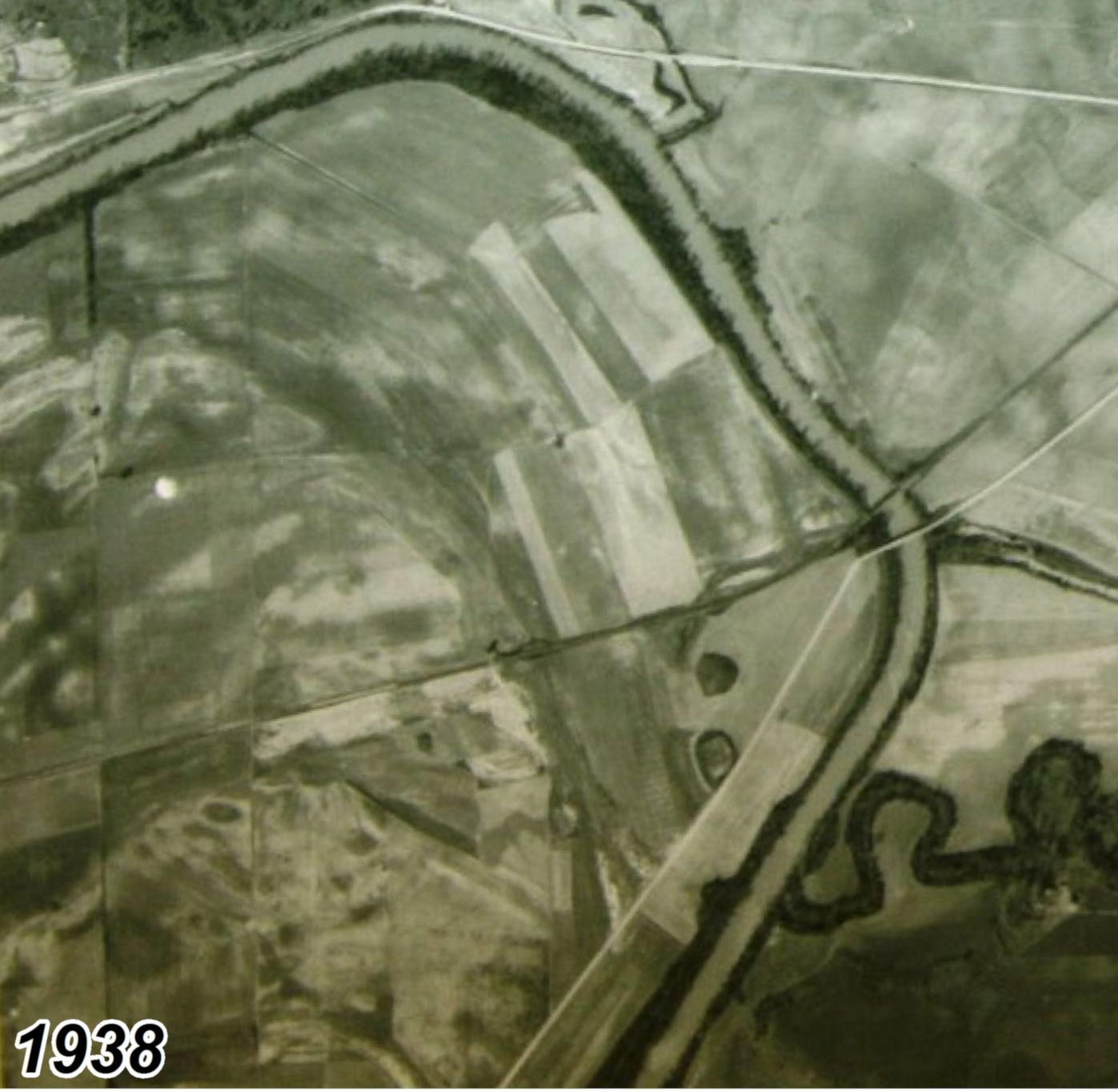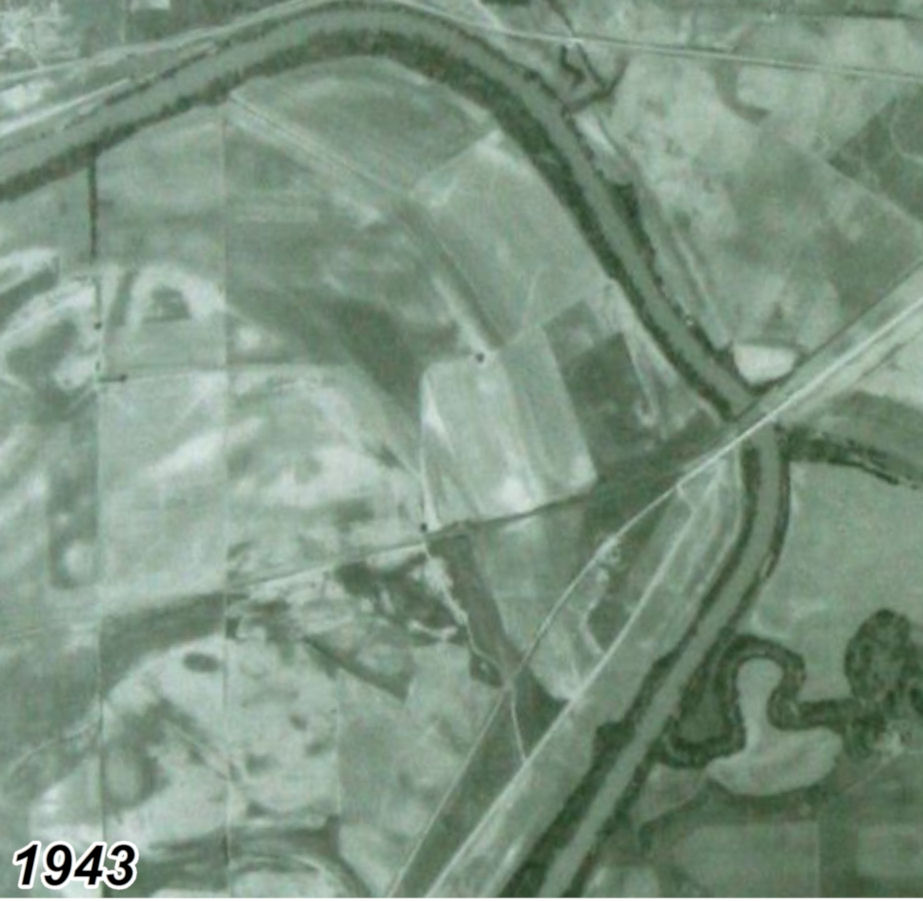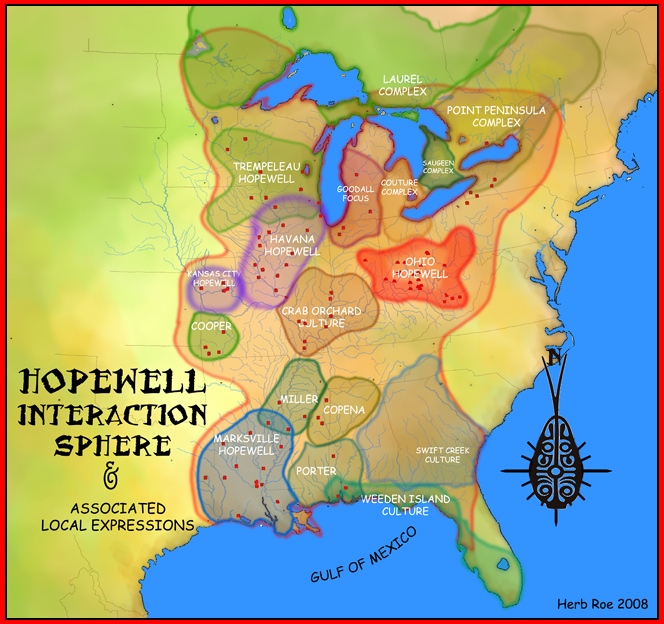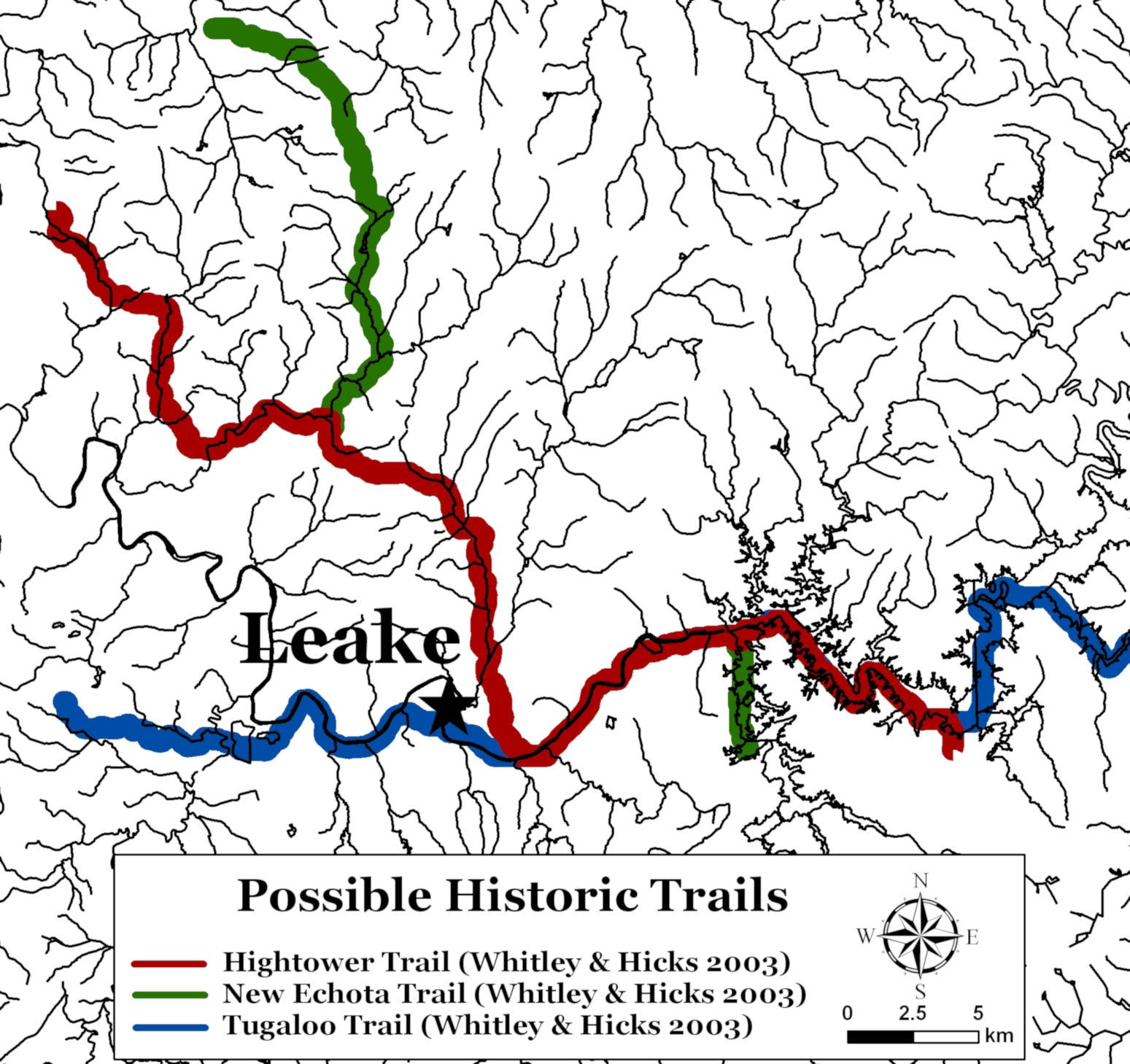Trail Panel #1: Time Travel
The Leake Site inhabitants first lived in modern-day Bartow County, Georgia, nearly 1,700 years prior to Christopher Columbus's "discovery" of North America in 1492.
Did you know that American Indian societies changed over time? Below you will find a podcast that explores the different periods of American Indian history.
Listen to Podcast
The Leake Mounds site is located within walking distance of the Etowah Indian Mounds. While the two sites are in close proximity, they were occupied during different periods. Listen to the following podcast to explore the various periods of American Indian history.
Interpretive Trail Panel (Time Travel)
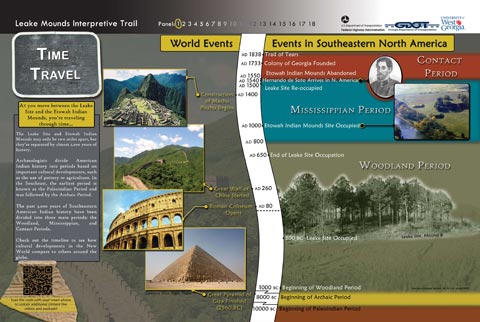
Trail Panel #2 (Not As Seen On TV)
What do archaeologists look for when they excavate a site? Below you will find podcasts and videos which indentify what archaeologists are looking for when they dig. View Not As Seen on TV Interpretive Panel
The arrival of Europeans in North America brought tremendous changes to American Indian societies. In this podcast we explore American Indian life after European contact.
Listen to Podcast
Archaeology provides us with the ability to explore American Indian life prior to the arrival of Europeans. In this podcast we learn more about American Indian life prior to European contact.
Listen to Podcast #2American Indian Bow & Arrow Use (Watch Video)
How did American Indian societies make and use bows and arrows? Watch a demonstration of how American Indians used these tools.
Pottery Techniques
How did American Indian societies create pottery? Watch as archaeologists demonstrate
the techniques used by American Indians to create pottery.
Watch Video![]()
Walking Tour
Watch as Scot Keith discusses how the Leake Site evolved over time.
Watch Video![]()
Trail Panel #3: Mounds and Moundbuilding
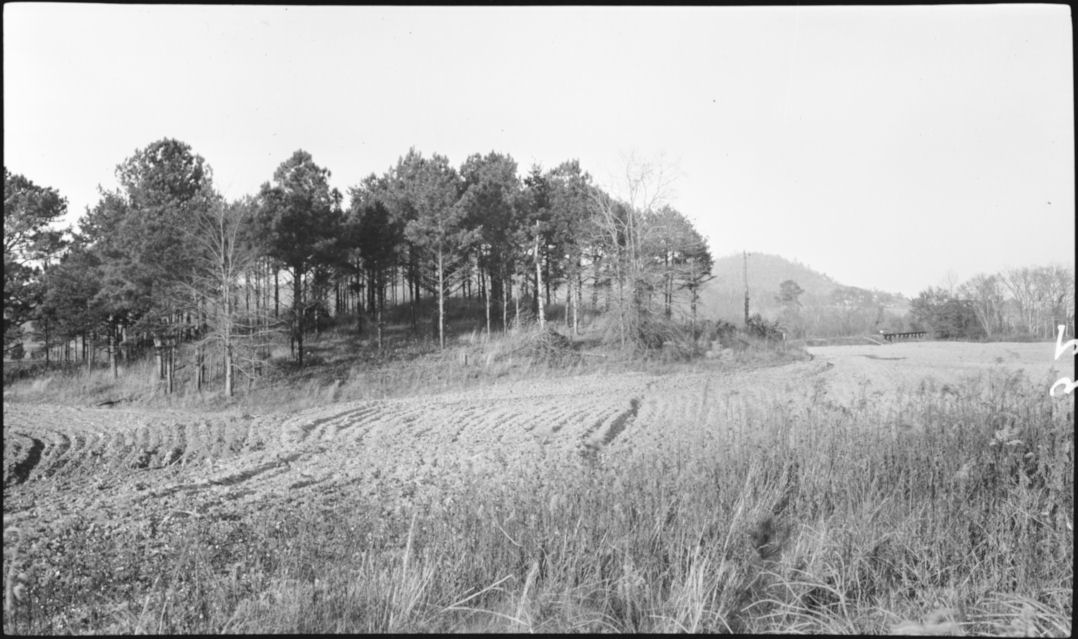
|
| Photograph of Leake Mound "B" taken in 1917. Click photo to view larger version. |
For centuries a lot of speculation and myth surrounded American Indian mounds. Who built these mounds and why? View Mounds and Moundbuilding Interpretive Panel
Listen to a Podcast
Have you ever wondered how American Indians built mounds? Listen to the podcast below to find out.
Join Archaeologist Scot Keith on a Guided Walking Tour
Watch as Scot Keith describes the three mounds that were once located at the Leake Site.
Trail Panel #4: Preserving the Past
Did you know that Federal laws exist that protect archaeological sites such as the Leake Site? Listen to the podcasts below to find out how Federal laws have protected this site.
View Preserving the Past Interpretive Panel
Preserving the Past - Integrity (Listen to a Podcast)
Listen to Georgia Department of Transportation archaeologists discuss how the National Historic Preservation Act affects their work.
Preserving the Past - Mitigation
Listen to Georgia Department of Transportation archaeologists discuss how their
office makes its findings available to the public.
Listen to Podcast #2![]()
Preserving the Past - Section 106
How does Federal law protect archaeological and historical sites? Listen to Georgia
Department of Transportation archaeologists discuss the basics of Section 106 of
the National Historic Preservation Act.
Listen to
Podcast #3![]()
Join Archaeologist Scot Keith on a Guided Walking Tour
Watch as Scot Keith describes the laws that exist that protect archaeological and historical sites.
Trail Panel #5: Clues about the Past
Have you ever wondered how archaeologists learn about societies that did not leave behind written records? Below you will find a podcast and videos which explore the types of clues that archaeologists use to learn about the past. View Clues About the Past Interpretive Panel
Listen to a Podcast
Learn more about the clues that archaeologists use when exploring an archaeological site.
Watch a Video
Learn about effigies found at the Leake Site.
Join Archaeologist Scot Keith on a Guided Walking Tour
Join Scot Keith as he looks for clues about life at the Leake Site.
Trail Panel #6: Can You Dig It
What do archaeologists look for when they excavate a site? Below you will find a podcast and a video which identify what archaeologists are looking for when they dig. View Can You Dig It Interpretive Panel
Listen to a Podcast
Listen to Georgia Department of Transportation archaeologists discuss issues pertaining to archaeological field work.
Can You Dig It (Watch a Video)
Watch as archaeologists use shovels and screens to locate artifacts found in the soil.
Tools of the Trade - Shovels and Trowels
Watch as archaeologists use shovels and trowels to locate artifacts found in the
soil.
Watch a Video #2![]()
Trail Panel #7: What's In a Site
Have you ever wondered how archaeologists know where to dig to locate artifacts? Watch the video below to find out how archaeologists identify potential archaeological sites. View What's In A Site Interpretive Panel
Watch a Video
Watch as archaeologists use ground penetrating radar to investigate archaeological sites.
Join Archaeologist Scot Keith on a Guided Walking Tour
Watch as Scot Keith discusses what archaeologists have learned about the Leake Site's inhabitants.
Trail Panel #8: The Unwritten Record
Oral traditions tell us a lot about American Indian culture. Many of these stories have been passed down from one generation to the next for centuries. Listen to the podcast below to learn more. View the Unwritten Record Interpretive Panel
Listen to a Podcast
Oral traditions help archaeologists understand more about American Indian culture. Listen to the podcast below to learn more.
"Circle of Stories" Website
Visit the PBS site "Circle
of Stories"![]() to learn more about American Indian storytelling traditions.
to learn more about American Indian storytelling traditions.
Trail Panel #9: Waterways
How did the Leake Site inhabitants use the Etowah River differently from the way you and I do today? Listen to the podcast below to find out. The Etowah River flows southwest from Dahlonega, Georgia, through Bartow County and into Rome, Georgia, where it meets the Oostanaula River. View Waterways Interpretive Panel
Listen to a Podcast
The Etowah River played a major role in the daily lives of the Leake Site inhabitants. Listen to the podcast below to learn more about the connections between the river and the Leake Site.
Join Archaeologist Scot Keith on a Guided Tour
Watch as Scot Keith discusses the significance of the Etowah River at the Leake Site.
 This map shows the network of waterways that
made the Leake Site accessible to American Indians between the Southeast and Midwest.
This map shows the network of waterways that
made the Leake Site accessible to American Indians between the Southeast and Midwest.
Trail Panel #10: Gateway Community
Did you know that American Indians from as far away as the American Midwest traveled to the Leake Site? Learn more about why the Leake Site was a gateway community below. View Gateway Community Interpretive Panel
Listen to a Podcast
Archaeologists unearthed artifacts at the Leake Site that originated from the American Midwest and other regions. How did these artifacts come to the Leake Site? Listen to the podcast below to learn more.
Trail Panel #11: Hopewell Interaction Sphere
How did artifacts created by American Indians living in the American Midwest end up at the Leake Site? Check out the video below to find out. View the "Hopewell Interaction Sphere" Interpretive Trail Panel
Join Archaeologist Scot Keith on a Guided Walking Tour
Watch as Scot Keith describes how the Leake Site was part of the Hopewell Interaction Sphere.
Trail Panel #12: Hidden Midden
Did you know that archaeologists can learn a lot about how people lived in the past
from middens--compost material remains from an extended period of human settlement
at a particular site? Listen to the podcast below to learn more about the Leake
Site's midden. View the Hidden Midden Interpretive Trail Panel![]()
Listen to a Podcast
What can archaeologists learn about the Leake Site inhabitants from the trash they left behind? Listen to this podcast to find out.
Join Archaeologist Scot Keith on a Guided Walking Tour
Scot Keith describes what middens can tell archaeologists about life at the Leake Site.
Trail Panel #13: On the Job
How do archaeologists make their findings available and understandable to the public? Watch the video below to learn more. View the On the Job" Interpretive Trail Panel
Watch a Video
How do archaeologists interact with the public? Watch this video to discover more about public archaeology.
Join Archaeologist Scot Keith on a Guided Walking Tour
Watch as Scot Keith describes what it meant as an archaeologist to work on the Leake Site excavation.
Trail Panel #14: Pieces of the Past
What can archaeologists learn about the past from broken pieces of pottery? A lot! Listen to the podcasts and watch the videos below to learn more. View the Pieces of the Past Interpretive Trail Panel
Listen to a Podcast
Archaeologists can learn a lot about American Indians from broken pieces of pottery recovered during excavations. Listen to this podcast to learn more.
Watch a Video
See how pottery vessels were made.
Trail Panel #15: The Past: Enjoy, Don't Destroy
Archaeological sites are threatened by a variety of human activities. How can we protect these sites? Listen to the podcast and watch the video below to find out more. View the The Past: Enjoy, Don't Destroy Interpretive Trail Panel
Listen to a Podcast
What potential threats do archaeological sites face? Listen to the podcast below to learn more.
Join Archaeologist Scot Keith on a Guided Walking Tour
Watch as Scot Keith discusses how many archaeological sites are threatened by human activity.
Trail Panel #16: Rivers, Roads, and I-75
Travel and transportation played a big part in making the Leake Site an important location. Listen to the podcast below to find out more. View the Rivers, Roads, and I-75 Interpretive Trail Panel
Listen to a Podcast
Did you know that American Indians used rivers to travel hundreds of miles? In this podcast you will discover why American Indians traveled to and from the Leake Site.
Trail Panel #17: Complex and Connected
The Leake Site's three mounds weren't the only features important to the people who lived here. Check out the podcast and video below to learn more about the connections between the Leake Site and its surrounding area. View the Complex and Connected Interpretive Trail Panel
Listen to a Podcast
Learn more about how other features in the area were important to the Leake Site's inhabitants.
Join Archaeologist Scot Keith on a Guided Walking Tour
Watch as Scot Keith describes how the Leake Site was part of a larger complex of sites throughout the area.
Trail Panel #18: From the Earth
Bartow County's mineral resources have played a major role in this area's development for more than a thousand years. Listen to the podcast below to find out more. You will also find a video that demonstrates how Native Americans transformed flint into projectiles. View the From the Earth Interpretive Trail Panel
Listen to a Podcast
Listen and learn about mineral resources in the Bartow County area.
Watch a Video
Watch as archaeologists demonstrate flint knapping.
Join Archaeologist Scot Keith on a Guided Walking Tour
Why did the Leake Site attract people from near and far? Watch as Scot Keith describes how geology and geography played major roles in the Leake Site's development.
